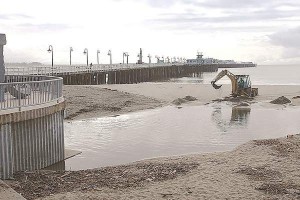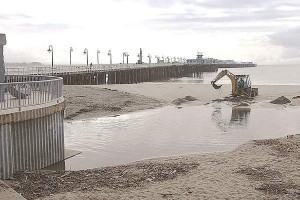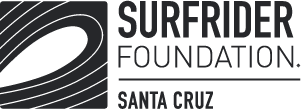
SANTA CRUZ (Story via Santa Cruz Sentinel)>> City and county officials who have teamed up with environmental experts to identify sources of persistent seasonal contamination at one of Santa Cruz’s busiest beaches hope to reduce spikes in bacteria and grow public awareness about causes and health risks.
The Cowell’s Working Group is collecting new monitoring data from the surf break off Cowell Beach and more closely tracking sources of human and animal waste. The group also is changing management practices of the Neary Lagoon outfall that empties onto the beach and considering the creation of a citywide sewer lateral inspection program.
 A backhoe loader is used to dig a channel from the Neary Lagoon Stormwater Outflow to the Monterey Bay at Cowell Beach last year. A working group studying contamination at Cowells considers the lagoon a potential source of bacteria. (Dan Coyro -- Santa Cruz Sentinel file)
A backhoe loader is used to dig a channel from the Neary Lagoon Stormwater Outflow to the Monterey Bay at Cowell Beach last year. A working group studying contamination at Cowells considers the lagoon a potential source of bacteria. (Dan Coyro -- Santa Cruz Sentinel file)
A progress report is expected before April, when the group is supposed to have completed its six months of work but will ask for an extension to study a full year’s data. The group also wants to analyze the economic impacts of health warnings posted on the beach when bacteria levels peak.
Councilman David Terrazas asked the City Council to convene the group after Cowells was named in May by Heal the Bay as having the worst water quality on the West Coast. Ninety percent of tests conducted on the beach in 2013 indicated bacteria levels higher than state standards.
In addition to its proximity to the tourism-driven Municipal Wharf, the site is located in a popular surf break and junior guards training area fronting the landmark Dream Inn. Cowell is also a short stroll from the iconic Beach Boardwalk and Monterey Bay National Marine Sanctuary Exploration Center constructed as a monument to a healthy bay.
The city and county have tried for years to identify sources of E. coli and enterococcus — consensus points mostly to birds — and study environmental conditions, such as stagnant water around the wharf and lagoon, that may contribute. But Terrazas urged greater collaboration with environmentalists and scientists to broaden perspectives about the pollution.
The group is made up of representatives from the City Manager’s Office and Public Works Department, Santa Cruz County Division of Water Resources, Saves the Waves Coalition, Coastal Watershed Council and the Santa Cruz chapters of Surfrider Foundation and Sierra Club.
“We came together because we needed to do something and unite all these disparate conversations going on,” said Nik Strong-Cvetich, executive director of Saves the Waves Coalition, which facilitates the group. “We also want to improve the public’s understanding of what the issue is. It’s a difficult problem to understand because there is not one source of bacteria that, when shunted off, solves the problem.”
The city installed a gate at the lagoon and is working on a diversion pump to block foul water from reaching the beach. Area sewer mains were replaced, but the city wants to ensure laterals connecting homes and businesses to the system are in good order. The city also may issue vouchers for private waste disposal aimed at avoiding illegal dumping by RV users.
“We want to get at any potential source and eliminate everything,” said County Water Resources Director John Ricker.
The county tests water quality at three points on the beach, but Surfrider Foundation has launched a monitoring site in the surf zone to understand contamination within the water and how it affects surfers and swimmers — none of whom have yet reported significant health effects.
“We have a population using the beach year round, so what we are seeing will give us background moving into summer, when we see the highest levels (of contamination),” said Sarah Mansergh, the foundation’s Know Your H20 program leader.
Group member Gillian Greensite, conservation committee chair for the Santa Cruz Sierra Club chapter, is interested in determining whether dog feces from the nearby unofficial off-leash Its Beach and West Cliff recreational pathway contributes to contamination.
“There is quite a bit that could be done,” she said. “It’s an educational issue.”
Author:
Reach the author at jbrown@santacruzsentinel.com or follow JM on Twitter: @jmbrownreports.
